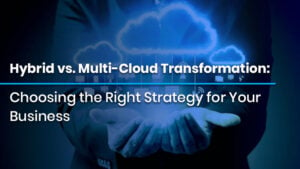
How to Strengthen Security Using CIS Controls and Posture Analysis
How to Strengthen Security Using CIS Controls and Posture Analysis Introduction In the fast-paced and ever-evolving world of cybersecurity, defending digital infrastructure goes far
Enhance your Skills in Cloud Computing , IP Networking , Microsoft , Artificial Intelligence , Cybersecurity and Many More . Come and Join IPSpecialist.

How to Strengthen Security Using CIS Controls and Posture Analysis Introduction In the fast-paced and ever-evolving world of cybersecurity, defending digital infrastructure goes far

How to Prepare for the AWS Data Engineer Exam Introduction With the world becoming increasingly data-driven, organizations are depending on cloud-based systems to store, process,

Hybrid vs. Multi-Cloud Transformation: Choosing the Right Strategy for Your Business Introduction In the digital-first economy of today, cloud transformation is no longer a
Table of Contents
As cloud computing continues to revolutionize the IT industry, Amazon Web Services (AWS) remains at the forefront, offering a vast array of services to meet the evolving needs of businesses worldwide. In 2024, AWS will continue to dominate the cloud market, providing a comprehensive suite of services designed to drive innovation, scalability, and efficiency.
This blog will explore the top 10 most used AWS services, highlighting their importance in cloud computing.
Dive deeper into the world of cloud technology and IT mastery with IPSpecialist! Get the best course by accessing comprehensive IT certification training and resources. From beginner-level IT courses to mastering Cloud Computing, Cybersecurity, DevOps, Microsoft, and more, IPSpecialist offers diverse courses, study guides, and practice exams tailored to amplify your skills.
AWS provides many offerings; however, positive ones are critical for numerous programs. Let’s delve into the top 10 maximum used AWS services.
Amazon EC2 is an essential constructing block of AWS Services, presenting scalable and resizable compute capacity inside the cloud. It gives digital servers (instances) that may be quickly provisioned and configured to host packages with varying workloads. AWS EC2 instances are customizable, allowing users to select the favored CPU, reminiscence, storage, and networking capacity. This flexibility makes EC2 perfect for various use instances, from the website hosting easy internet packages to going for walks with complex, facts-in-depth workloads.
Amazon RDS is a wholly controlled relational database provider that simplifies database administration responsibilities with setup, patching, and backups. It supports multiple database engines, including MySQL, PostgreSQL, Oracle, and Microsoft SQL Server. RDS is designed to automate routine database tasks, permitting developers to focus on application improvement instead of database management. It presents excessive availability, automatic backups, and smooth scalability, making it a handy desire for organizations requiring a robust and scalable relational database answer.
Amazon S3 is a scalable and sturdy object storage service designed for storing and retrieving any quantity of records at any time. It is a foundational component for diverse AWS offerings and is typically used for information storage, backup, and archiving. AWS S3 is characterized by its simplicity, scalability, and coffee-latency to get admission to saved records. It supports capabilities like versioning, access manage, and occasion notifications, making it a flexible solution for coping with various facts storage desires.
Amazon CloudFront is a Content Delivery Network (CDN) provider that hastens the transport of internet content material to customers internationally. CloudFront reduces latency by dispensing content material throughout a worldwide community of edge places and complements the consumer experience. It can be integrated with different AWS offerings, including S3 and EC2, to supply static and dynamic content material efficiently. CloudFront additionally affords protection features, which include DDoS protection and SSL/TLS encryption, ensuring a secure and reliable content shipping infrastructure.
Amazon VPC allows users to safely connect AWS sources and make more extensive on-premises networks into the AWS cloud. It gives a logically remoted segment of the AWS cloud where customers can define their community configuration, consisting of IP cope with stages, subnets, and routing tables. VPC gives control over community protection, allowing users to configure firewalls and create non-public subnets. This degree of customization makes Amazon VPC an essential carrier for building a secure and flexible community infrastructure within the cloud.
Amazon SNS is a controlled messaging service that helps send messages to a distributed set of recipients. It supports multiple conversation protocols: HTTP, HTTPS, email, and SMS. SNS simplifies the technique of sending messages, notifications, and signals, making it a valuable device for constructing scalable and decoupled architectures. With SNS, developers can easily broadcast messages to many subscribers, enhancing conversation efficiency in disbursed structures.
AWS Elastic Beanstalk is a Platform-as-a-Service (PaaS) imparting that simplifies the deployment and control of applications. It supports multiple programming languages and frameworks, allowing builders to be mindful of writing code without demanding approximately the underlying infrastructure. Elastic Beanstalk handles application deployment, potential provisioning, load balancing, and car-scaling, streamlining the improvement and operational procedures. This makes it an excellent preference for agencies seeking a platform that combines flexibility simply of use.
AWS Lambda is a serverless computing carrier that enables the execution of code in reaction to occasions without the want for server provisioning. Developers can upload code snippets (features) to Lambda, and the carrier routinely takes care of scaling, monitoring, and preserving the infrastructure required for execution. Lambda is event-pushed and supports integration with diverse AWS offerings, making it a powerful tool for building scalable and fee-powerful applications that respond dynamically to changes in workload.
AWS Autoscaling is a provider that robotically adjusts the number of EC2 times based on defined regulations or adjustments in demand. It maintains software performance and optimizes value by dynamically adjusting resources to shape the contemporary workload. Autoscaling may be configured to scale horizontally (adding extra times) and vertically (adjusting the ability of current times), providing a flexible and automatic solution for managing varying stages of traffic and demand.
AWS IAM is a centralized service for securely handling entry to AWS sources. It permits agencies to define and manipulate who can get admission to particular assets and what moves they could perform. IAM provides a granular level of manipulation over consumer permissions, roles, and rules, allowing corporations to adhere to the precept of least privilege. By managing identities and getting entry, IAM enhances the security posture of AWS environments and ensures that the best legal individuals or structures can interact with sources.
As cloud adoption continues, the demand for skilled professionals with expertise in AWS services is expected to surge. This will focus on training and development initiatives to bridge the talent gap.
In closing, the top 10 most used AWS services we’ve discussed are the bedrock of cloud computing and app development. AWS covers a broad spectrum of needs, from scalable computing power with EC2 to fully managed databases via RDS. Essential services like S3 for storage, VPC for security, and IAM for access management highlight AWS’s commitment to robust and secure cloud solutions. Additionally, services like Lambda and Autoscaling point to serverless and automated infrastructure trends, streamlining app deployment and cutting costs. These services empower businesses to innovate and grow in today’s digital landscape.
Get started today and revolutionize your business using AWS Cloud Service!
AWS is Amazon’s cloud computing platform, offering computing power, storage, databases, machine learning, analytics, and networking services.
AWS provides scalability, cost-effectiveness, reliability, security, and flexibility, enabling businesses to innovate and grow without heavy upfront investments.
AWS offers On-Demand, Reserved, Spot Instances, Savings Plans, and free tiers, allowing users to choose pricing based on their usage needs.
© 2025 All rights reserved | Privacy Policy | Terms and Conditions | Sitemap | Cookie Policy




